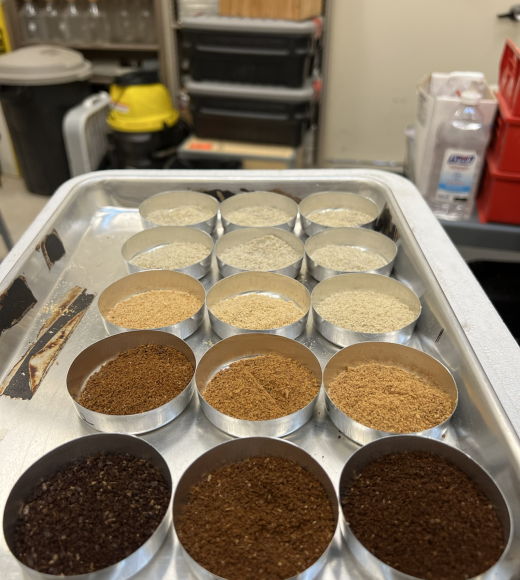Grounds for Discovery
New research on coffee acidity charts a roadmap for better roasting
Nutty, sweet, bitter and salty: These are common flavor notes in a cup of coffee. But there is also a brightness or acidity, reminiscent of citrus, called "perceived sourness," that is an inherent trait of the brew. In fact, this sourness is so important to coffee that there's a whole scoring category for it in cupping competitions.
A 2021 paper by researchers from the University of California, Davis' Coffee Center in the College of Engineering, including William Ristenpart, co-director of the center and professor of chemical engineering, revealed that the perceived sourness of coffee is strongly correlated to its titratable acidity, or TA, which is the measure of the total amount of acids present. Prior to this publication, the coffee industry had associated the sourness with the coffee's pH levels.

Laudia Anokye-Bempah, a Ph.D. student in biological systems engineering, used this finding as a starting point for her research, investigating how TA changes during roasting. Her goal is to bring roasters' attention to the importance of TA to perceived sourness, one of the dominant flavor profiles in brewed coffee. Her findings were recently published in Nature.
Crafting the Roast
To gather the data, Anokye-Bempah and a team of researchers, including Timothy Styczynski, head roaster for the Coffee Center, defined seven roast profiles by their heat applications versus time measured inside the roaster, representing a variety of profiles typically used in the coffee industry.
For instance, the "Fast Start" profile involved a high initial heat application followed by a steady decrease in roast energy, while the "Slow Start" profile began with a low initial heat application followed by a gradual acceleration in roast energy.
Using these roast profiles, Anokye-Bempah and a team of undergraduate researchers roasted coffee beans from different countries of origin and post-harvesting processing methods: African-washed coffee from Uganda's Sipi Falls, honey-processed coffee from Ataco in El Salvador and an Indonesian-washed coffee from Sumatra.

Each roast lasted 16 minutes to allow sufficient time to investigate subtle changes in the TA from the green coffee stage to the burnt or charred coffee stage. The researchers collected samples, approximately 13 grams each, at one-minute intervals, resulting in a total of 17 samples (from minute 0 to 16) for each of the seven roast profiles.
The samples were immediately cooled in liquid nitrogen to prevent any further chemical changes outside the roaster and then transported to the lab, where they were ground and brewed for TA analysis.
Pouring Over the Details
The corresponding data showed that for all three coffees and across all roast profiles, the TA significantly increased from the beginning of the roast to the "first crack" phase (when the coffee beans make a popping or cracking sound) where it peaked, and then continuously decreased until the end of the roast.
While these findings aligned with previous studies, Anokye-Bempah and her team made additional key observations. Firstly, TA consistently peaked during the first crack, regardless of the roast profile or coffee origin. Secondly, by the onset of the second crack, the TA decreased to approximately its initial value at the beginning of the roast.
While the TA remained consistent across roast profiles, the different roast profiles did affect the TA dynamics. For example, the "Fast Start" profile led to quicker changes in TA compared to the "Slow Start" profile. The team also found no significant differences in TA dynamics across the various coffee origins and postharvest processing methods that were tested.
Charting Coffee's Research Horizon

Anokye-Bempah believes that key insights into coffee quality parameters, such as TA, can provide valuable information to people in the coffee industry, giving them more control over the flavor of their coffee.
"There's only so much you can do to alter the sensory properties of your coffee at the brewing stage," she said. "The roasting process offers far greater control over your coffee's flavor."
Anokye-Bempah's goal with her research at the Coffee Center is to create a coffee roasting control chart, similar to the industry's brewing control chart, which indicates how strong or weak coffee would be depending on the amount of coffee grounds, water and time. Anokye-Bempah says that a lot more research and data are required to create one for roasting. Luckily, she already has many of these measurements in the queue.
"This data on titratable acidity is just one measurement out of 16 different measurements we made. More exciting results are still to come."
Media Resources
- Jessica Heath, Content Specialist, jesheath@ucdavis.edu
